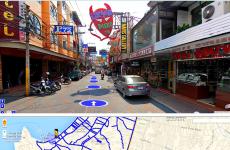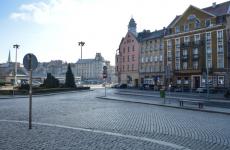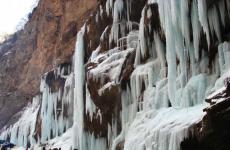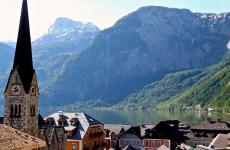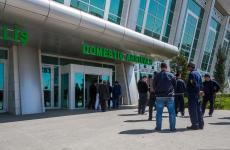You are here: - - - Bison. Where are bison found? Prioksko Terrace Reserve what is there
The Prioksko-Terrasny Natural Biosphere Reserve is undoubtedly a natural pearl of the Moscow region (and the only state reserve on its territory). On April 30, we finally managed to visit it and get to know better the richness and diversity of the region’s nature. Here the flora and fauna are presented approximately in the form in which it existed in most of the south of the Moscow region (in the Poochya region) before active settlement by humans.
Pristine landscapes
The reserve was founded on June 19, 1945 (a month after the Victory!), and the bison nursery (probably the main tourist attraction) - in 1948. Bison previously inhabited a large territory of Europe and Asia, but in the 20th century their existence was under threat. The daily work of the reserve’s staff is devoted to the conservation, study and distribution (restoration) of this ancient species of the largest mammals in Europe.
So, a short photo report with explanations.
The bison nursery is located in the village of Danki. You can visit it as part of regular excursions (from April 1, 2018 until the autumn-winter period, they are daily from 9 a.m. to 4 p.m., current information is on the website). On weekends there are usually many more visitors, so it’s worth arriving early.

Our guide Natalya had a very large group.

Bison are not afraid of people and calmly walk along fences

Young bison

A large number of visual and informative stands will tell you a lot of interesting things. This one is about ants.

To the left and right is the zone of bison and bison. Photo from the observation tower

Differences between bison and bison

bison family

Here are all the animals presented at the stand, except perhaps the wolf
By the way, a lynx lives in the reserve, and it appeared on the territory of the reserve illegally and on its own. Perhaps she escaped from someone's illegal private collection. The lynx is a “vast” predator (like the wolf) and it needs significant hunting grounds, which for objective reasons are not available in the reserve. By the way, a lynx was also seen in the Ozersky district of the Moscow region during forest fires in 2010.
During the tour you can learn many interesting facts, but I will not reveal all the cards. The Prioksko-Terrasny Natural Biosphere Reserve is a must-see.
PS Special thanks to the guide Natalia for the fascinating story, as well as to all the staff of the reserve for their work.
Bison(Bison bonasus)- a wild forest bull, the largest ungulate animal on the European continent, which is rightfully considered a contemporary of the mammoth. Bull body length reaches 3 – 3.5 meters, shoulder height 1.7 – 2 meters, weight can reach one ton. The bison's fur on the front part of the body is thick, soft and long, which visually makes it appear even more massive and powerful. But the bison’s voice is more like a dull grunt and does not fit well with the impression of the animal – a giant.
Written data about the bison has been known since the 3rd century BC, and the fossil remains of the ancestors of the bison date back to the Pliocene (1.5 million years ago). For most peoples, this powerful and beautiful animal personified the forces of nature, had a traditional cult meaning, and was worshiped as one of the symbols of their native land.
The bison is a symbol of the entire environmental movement to save rare and endangered species of animals. Thanks to breeding in nurseries, it has become the only species in the world that has survived only in captivity and is successfully returning to the wild!
Only man is to blame for the disappearance of the bison in the wild. Poaching, cutting down and burning forests, and the unrestricted shooting of animals during periods of wars, popular unrest and revolutions led to the fact that by 1927 the bison was completely exterminated in the wild. In 1927, all over the world, and only in captivity, there were only 48 bison left in European zoos. From 1933 to 1939, there lived in the USSR a single purebred bison named Bodo, miraculously preserved in a reserve near Kherson.
Thanks to the activities of nurseries and zoological gardens, the bison was saved from complete extinction. Now world population size There are about 4,500 bison, of which about 3,000 animals live in the wild.
How long do bison live?
Bison cannot be considered one of the longest-living animals. Their lifespan is relatively short and does not exceed 30 years. Males usually live 10 years less than females. The recorded age limit for males is 23 years, but most of them die of old age at the age of 19-20 years. Bison grow quite slowly. Males reach full physical development by 10 years, females by 7 years.
How long does bison pregnancy last?
Females bring their first bison when they reach the age of three. Pregnancy lasts about 9 months. Nine to ten month old calves are separated from their mothers. Most bison calves are born in May-June.
What do bison eat?
Bison feed on herbaceous and woody plants. They graze mainly in forest clearings and in the floodplains of small rivers and streams, and in the fall in mown clearings, eating the remnants. The most favorite tree species are willow, aspen and oak. Bison eat thin branches with leaves, strip off young trees and eat the bark. They love acorns very much.
In the nursery, in the summer, bison are fed twice a day with compound feed and wood feed, and in winter they also add hay and succulent feed - chopped beets or carrots. On average, an adult bison receives about 2 kg of feed per feeding, and an adult bison – 3 kg. Bison begin to receive dry food from the age of two months. Each pen has salt lick with mineral additives.
What is the character of a bison?
By their nature, bison are rather timid, shy animals. In the forest, when free, they usually avoid meeting people and, when they see him, run away. In the pens of the nursery they behave much more boldly, although they obey the bison breeders. Bison remember very well the sounds that accompany the distribution of food. For example, in a nursery, bison come for breakfast and dinner (they do not have lunch) at the sound of a hunting horn or bugle.
 What is the difference between bison and bison?
What is the difference between bison and bison?
The differences between bison and American bison are minor. The bison has a higher hump, different in shape, longer horns and a tail. The bison's head is set higher than that of the bison. The bison's body fits into a square, while the bison's body fits into an elongated rectangle, that is, the bison has a longer back and shorter legs. In the hot season, the back of the bison is covered with very short hair, almost bald, while the bison has hair developed all over its body at all times of the year. Both species are approximately the same in size, although the American bison, due to its stockiness, looks more compact and stronger.
Hello our dear readers. You may be surprised, but there is only one nature reserve in the Moscow region. It is called the Prioksko-Terrasny Reserve. Moreover, it is also one of the largest in Russia. You will find out further what else this place is famous for.
Story
The Prioksko-Terrasny Biosphere Reserve is located on the banks of the Oka, as you probably already guessed by its name, in Moscow, Serpukhovo district.
It was created by 1945. And initially it was one of the sections of the large Moscow nature reserve. Later, each section became independent, and even later they were abolished. All except Prioksky. So he turned out to be the only one in the entire Moscow region.

Sunset on the Oka
By 1979, it became a biosphere and also received a UNESCO certificate, which confirmed that these lands were included in the global network of nature reserves. At the same time, the tasks of the reserve expanded. A monitoring station was created whose responsibilities included monitoring the state of the environment and the pollution that enters the protected area.
Flora
Well, now from history we invite you to slowly move on to the inhabitants and features of this interesting place. Let's start with the flora. It's hard to believe, but there are about 960 plant species here.
Forests, linden-oak, and also consisting mainly of pines, lindens, spruces, oaks, birches and aspens, occupy 93% of the area of the entire reserve.

Kashubian peas

Mordovnik
In addition to the trees already listed, broom, sedge, gorse, lingonberry, blueberry, wild rosemary, cinquefoil and other plants grow in this area. It may take too much time to list all the diversity. We won't bore you.


Bieberstein Tulip
Plants in the south of the reserve are considered especially valuable; they are called “Oka flora”. It was discovered by MSU professor Kaufman. Representatives of the flora more typical of northern meadow steppes grow here: feather grass, strawberries, geraniums, steppe cherry, Russian hazel grouse, etc.
Fauna
Among the grasses and trees, 56 species of mammals live here. Plus two more species - the American steppe bison and the bison - live in the nursery. And that is not all! 139 species of birds, 10 species of amphibians, 8 species of fish and 5 species of reptiles. For example, among the birds you can find black grouse, wood grouse, hazel grouse, honey beetles, and black kites. Most of the birds here are migratory. By the way, six species of local birds are listed in the Red Book.

The dominant position among the local inhabitants is occupied by ungulates. Their numbers are considered too large for such a territory. Moose, deer, roe deer, and wild boar live here. Also, bison are in a special position of protection here. In order to restore this species, a nursery was created in the reserve, which, it must be said, copes with its responsibility perfectly.


Swallowtail caterpillar
Foxes, moles, hedgehogs, shrews, hares, mice, rats, squirrels, raccoon dogs, beavers, lizards, toads - you name it. Among the animals there are also representatives of the Red Book, for example, the same bison.

The reserve is also engaged in restoring populations of beaver and roe deer, species that were exterminated by the beginning of the 20th century.


Another area of work is the study of insects and spiders. Half of the spider species do not spin webs.
On video: bison, spiders and more
Birds 142 species of birds, 57 species of animals, 625 species of butterflies
On video: winter bird count
Important tasks
Another important function of the reserve is education. It is conducted through the media, various conferences for school students. A lot of work is also done with those who come here on excursions. After all, everyone can visit the local Museum of Nature, as well as some accompanied by guides. Such excursions are accompanied by lectures about the history and modern life of the reserve. And they are held every day.

Central estate. There are ticket offices and a museum there.
In addition, everyone can help the world around them and this place especially by taking part in Volunteer Day. You will contribute to the improvement of the territory of the reserve, and in return they will organize a free excursion for you.
Information for visitors
Tours are offered daily. A lot of them. Their price varies from 1000 to 300 rubles. For groups, the cost ranges from 4000 to 2000.
Information on the official website: www.pt-zapovednik.ru
How to get there
- By car you need to travel from Moscow along the Warsaw Highway to the south. Then along Simferopolsky and turn off at the Serpukhov/Danki sign. In Danki, follow the Main Road sign, after the bridge over Sushka, turn right.
- You can take the train from Kursky Station to Serpukhov. Then take buses 31, 41 or 25.
Address: Moscow region, Serpukhov district, Danki
Prioksko-Terrasny Nature Reserve on the map
Friends, discover new things with us. Thanks for your subscriptions. See you later!
BISON, Belovezhsky subspecies and intraspecific hybrid forms
Bison bonasus (subspecies bonasus)
|
VERTEBRATES – VERTEBRATA Squad:Artiodactyla – Artiodactyla Family:Bovids – Bovidae Genus: Bison Linnaeus, 1758 |
Spreading: The current habitat of the bison in Russia was formed as a result of practical measures to resettle animals bred in captivity (in specialized nurseries and zoos) into natural habitats. At the first stage of implementing the strategy for the conservation and restoration of bison, isolated populations were created in order to subsequently reconstruct a new range of the species through their natural merging. On the territory of Russia there are 2 regions inhabited by herds of bison: North. Caucasus and the Center of the European part. To the North In the Caucasus, 2 large populations have been created: the first includes the territory of the North Ossetian Nature Reserve, the Tseysky Nature Reserve and the North Ossetian Game Reserve, the second - the Arkhyzsky section of the Teberdinsky Nature Reserve. In addition, 2 herds of bison - on the territory of Ingushetia (Sunzhenskoe hunting farm) and Chechnya (Assinsky reserve) fell into the zone of instability, which raises concerns about their continued existence. The European Center has isolated herds of bison in the Tver region. (Sknyatinskoe hunting farm), Vladimir region. (Velikoozersk hunting farm), Rostov region. (Fominsk reserve) and Vologda region. (Suselskoe hunting farm).
Habitat:Modern bison are descendants of animals bred in captivity, but when introduced into natural lands, they prefer the same habitats that were characteristic of exterminated native forms, namely: broad-leaved and mixed forests with dense undergrowth. For bison, it is important to alternate vast forests with open spaces (meadows, forest edges, fields). Avoids swamps and highlands. In the anthropogenic landscape it uses secondary forests. The bison is a herd animal. The herd has a variable composition depending on the season of the year: in winter, in feeding areas, individual groups unite into large agglomerations (up to 100 or more animals), in the spring these associations break up into family herds of 10-15 individuals. Family groups are formed by several sexually mature females, often in related relationships, as well as non-breeding young bison up to 3 years of age. Such families are joined by mature bulls, who usually stay apart, either in small groups (young bulls) or alone (old males). The sex ratio in established bison populations is 48% males and 52% females. Sexual maturity in bison occurs at 2-3 years of age, but males are allowed to breed in wild herds at 5-6 years of age, females at 3-4 years of age. Rutting in August-October, calving in May-June. The female gives birth to 1 calf, in exceptional cases - 2. In captivity, childbearing occurs annually, in the wild - once every 2-3 years. The lifespan of bison is up to 24 years (in exceptional cases up to 27-28 years), bull bison is up to 20 years (in exceptional cases up to 22 years). Bison are sedentary animals. However, young males can migrate over a distance of several tens of kilometers from their herd. In some cases, migrations up to 300 km . In the Caucasus Mountains, bison populations develop seasonal altitudinal migrations; in autumn - to the foothills, in spring - to the upper forest zones with access to subalpine meadows.
Number:The bison escaped extinction thanks to captive breeding. The gene pool of the modern world population of purebred bison is derived from the recombination of genes of 12 individuals, called “founders”. Among them, 11 individuals represented the nominal Belovezhsky subspecies (B. b. bonasus) of the last generations of indigenous animals of Belovezhskaya Pushcha at the end of the 19th and beginning of the 20th centuries. and 1 individual (male) of the extinct Caucasian subspecies (B. b. caucasicus). However, modern Belovezhsky bison have among their ancestors only 7 of the 11 last representatives of the nominal subspecies, while Caucasian-Belovezhsky bison have all 12 founders. Thus, the gene pool of purebred bison during 1918-1945. passed through the so-called “bottleneck”, which predetermined the main limiting factor influencing the prospects for the restoration of this species - weak genetic variability and the predisposition of bison populations to genetic degeneration. The second important factor determining the growth of the bison population is the limit of favorable habitats within the boundaries of the species’ former range: Central and Eastern. Europe, as well as in the Caucasus. The ongoing intensive transformation of these bison habitats limits the growth of already established local populations in Poland, Ukraine and Belarus. Suitable habitats for the species over fairly large areas are found only in Russia in the European center and in the north-west. To the beginning 1992 . The world bison population amounted to 3.5 thousand individuals, of which almost 2 thousand lived in complete freedom in free herds, the rest were in zoos and nurseries. In Russia on January 1 1994 . 53 Belovezhsky and 346 Caucasian-Belovezhsky bison were counted. Of these, 121 individuals were in nurseries and zoos, the rest in free populations. According to the results of the All-Russian accounting 1996 . 354 bison were counted, including 241 bison in free populations in 8 locations. In the last 2 years, there has been a tendency towards a reduction in the number of bison in Russia in comparison with previous periods. The main reason is a decrease in the reproduction of young bison in nurseries and zoos, a reduction in the number of the largest free population of Caucasian-Belovezhsky bison in the Tseysky reserve of the North Ossetian nature reserve due to heavy snow and harsh winters of 1991- 1993
|
Sources:1. Pererva, 1991; 2. Red Book of the RSFSR, 1983; 3. Pererva, 1992; 4. Pererva, Kiseleva, 1991; 5. Lipkovich, 1985; 6. Slatis, 1960; 7. EVRV, 1993; 8. Pererva, 1997. Compiled by: IN AND. Pererva |
The Prioksko-Terrasny Nature Reserve is one of the smallest nature reserves in Russia, the only one in the Moscow region. The reserve owes its name to its proximity to the Oka River and the terrace-like steps in the relief that were formed more than 10 thousand years ago.
In the southern part of the reserve there are Dolys - unique areas of growth of steppe plants, the existence of which is associated with the phenomenon of “Oka flora”. The area of the valleys is about 10 hectares. Precisely the presence on the territory relic elements of steppe vegetation was one of the key reasons for organizing the reserve.
Location of the reserve: Moscow region, Serpukhov district, Danki town. We leave Moscow along the M-2, drive for a long, long time, turn off at the sign “Serpukhov, Danki”. Straight ahead, about 4 km, in the village of Danki, following the sign “Main Road”, take a right and, having passed the bridge over the Sushka River, after 200 m turn right at the sign “Reserve / Excursion Bureau”. We are in place!
Excursion routes – the Bison Nursery and the Museum of Nature – accept visitors from 9 a.m. to 4 p.m., all year round and seven days a week. Excursions start every hour, we arrived at about 10:40, immediately bought tickets (preschoolers are free, an adult ticket in the summer of 2013 costs 200 rubles) and began to explore the situation. A new administrative building, apparently with a hotel, a free toilet, a free booklet about the reserve, everything for tourists!
At 11:00, without delay, Olga, the tour guide, joined our group. There were many children in the group, so it was decided to drive cars as close as possible to the entrance to the bison nursery, so as not to get tired ahead of time. The walk was going to be long.
 Central bison nursery created on the territory of the Prioksko-Terrasny Nature Reserve in 1948. That same year, the first animals were brought here from Poland. Now the nursery covers an area of 200 hectares, designed to support 50-60 animals, of which 20-25 are breeding animals, the rest are young animals, which the reserve resettles within the former habitat. Over the 65 years of its existence, it was removed from the nursery more than 300 purebred bison, most of them were released into the wild to live in natural conditions. Based on the population of bison taken from the nursery, about 20 free-living herds of bison were created, now living in Russia, Belarus, Ukraine and Lithuania. In 1979, the reserve entered the UNESCO World Network of Biosphere Reserves.
Central bison nursery created on the territory of the Prioksko-Terrasny Nature Reserve in 1948. That same year, the first animals were brought here from Poland. Now the nursery covers an area of 200 hectares, designed to support 50-60 animals, of which 20-25 are breeding animals, the rest are young animals, which the reserve resettles within the former habitat. Over the 65 years of its existence, it was removed from the nursery more than 300 purebred bison, most of them were released into the wild to live in natural conditions. Based on the population of bison taken from the nursery, about 20 free-living herds of bison were created, now living in Russia, Belarus, Ukraine and Lithuania. In 1979, the reserve entered the UNESCO World Network of Biosphere Reserves.
 In front of the entrance to the nursery there is a “ disinfection station» – a small house with sawdust on the floor. The sawdust is treated with a special compound so that no microbe brought by tourists threatens bison and bison. We pass, we trample.
In front of the entrance to the nursery there is a “ disinfection station» – a small house with sawdust on the floor. The sawdust is treated with a special compound so that no microbe brought by tourists threatens bison and bison. We pass, we trample.
The tour of the bison reserve takes place along long corridors between the paddocks. The corridors have recently been paved, so you no longer need to take rubber boots! The total distance is about 1.5 km one way. Us lucky, despite the heat, the bison and bison were close to the corridor, so we were able to take a close look at everyone.
 Bison- the largest mammal on the European continent, the same age as the mammoth, a powerful and ancient wild bull that found itself defenseless against civilization. After the First World War, wild bison were still found in two places: in Belovezhskaya Pushcha and in the Caucasus, but the last individuals were killed in the 20s: in Belovezhskaya Pushcha in 1923, in the Caucasus in 1926. In 1923, the International Society for the Conservation of Bison was formed - all the animals were recorded and given numbers. In the middle of the century it was discovered that there were only 48 live bison, and even those are in captivity. Painstaking work has begun to restore and resettle bison in nature reserves and wild forests. This is what the Central Bison Nursery in the Prioksko-Terrasny Nature Reserve does.
Bison- the largest mammal on the European continent, the same age as the mammoth, a powerful and ancient wild bull that found itself defenseless against civilization. After the First World War, wild bison were still found in two places: in Belovezhskaya Pushcha and in the Caucasus, but the last individuals were killed in the 20s: in Belovezhskaya Pushcha in 1923, in the Caucasus in 1926. In 1923, the International Society for the Conservation of Bison was formed - all the animals were recorded and given numbers. In the middle of the century it was discovered that there were only 48 live bison, and even those are in captivity. Painstaking work has begun to restore and resettle bison in nature reserves and wild forests. This is what the Central Bison Nursery in the Prioksko-Terrasny Nature Reserve does.
 The nursery maintains the purity of the species - these are bison, without the common bison admixture. Bison and bison They belong to the same biological genus and are capable of producing offspring, which are called “bison”. Bison and bison are sometimes even considered as a single species, but serious researchers are categorically against such generalizations: the North American bison and the European bison appeared and lived in completely different territories. There are also bison in the bison forest of the Prioksko-Terrasny Nature Reserve, but they are kept separately from bison and are not bred or resettled.
The nursery maintains the purity of the species - these are bison, without the common bison admixture. Bison and bison They belong to the same biological genus and are capable of producing offspring, which are called “bison”. Bison and bison are sometimes even considered as a single species, but serious researchers are categorically against such generalizations: the North American bison and the European bison appeared and lived in completely different territories. There are also bison in the bison forest of the Prioksko-Terrasny Nature Reserve, but they are kept separately from bison and are not bred or resettled.
 They explained to us how to distinguish between bison and bison. My daughter immediately noticed the difference, naming bison "holopop"" Bison's hair is concentrated “in the first half of the body,” and a clear boundary is visible where there is hair and where there is not. Bison, on the contrary, are evenly covered with hair. In addition, bison have a long beard, while bison do not. In general, after 5 minutes we could easily distinguish one from the other.
They explained to us how to distinguish between bison and bison. My daughter immediately noticed the difference, naming bison "holopop"" Bison's hair is concentrated “in the first half of the body,” and a clear boundary is visible where there is hair and where there is not. Bison, on the contrary, are evenly covered with hair. In addition, bison have a long beard, while bison do not. In general, after 5 minutes we could easily distinguish one from the other.
In addition to bison and bison, in the reserve we found lamb, herd roe deer And boars. The children were happy, the zoo is not a zoo, but they saw different animals. You need to understand that the reserve is of much greater interest not for tourists, but for botanists (this is the difference between a reserve and a national park). After all, the main mystery The Prioksko-Terrasny Nature Reserve contains not animals, but plants. On the banks of the Oka River in the area of the reserve, a unique community of steppe plants was discovered, completely uncharacteristic for these places. How did southern steppe plants get into the northern forests near Moscow, being separated from their natural range by 600 kilometers? Scientists cannot yet definitively answer this question.
 The walk lasted an hour and a half, and at the end of the excursion we were invited to visit Museum of Nature, where they spoke in detail and clearly about the flora and fauna of the southern Moscow region.
The walk lasted an hour and a half, and at the end of the excursion we were invited to visit Museum of Nature, where they spoke in detail and clearly about the flora and fauna of the southern Moscow region.
Overall rating of the trip: 4+. Among the mini-disadvantages: the route through the reserve is quite long for children. If under three years old, you need some kind of transport, a stroller, a bicycle. We don’t pay attention to the supposed “scarcity” of the animal world, the main thing is a walk in the fresh air in a new place!
Official website of the reserve: http://pt-zapovednik.ru/
Driving directions:
P.S. We spotted it on posters in the reserve. Now we call it correctly:
Reserve– a section of territory or water area for which, in order to preserve the entire natural complex and biological diversity are completely excluded all production forms of economic activity and scientific research is allowed, the methods of which do not introduce disturbances and disturbances in the natural course of natural processes. A reserve is an environmental and research government organization, usually under federal subordination.
National Park– a vast protected area, the natural conditions of which were not subjected to significant changes under human influence, or where human activity has historically harmonized with nature, in which landforms, vegetation and fauna are of great interest or have great picturesqueness, intended for the preservation of biodiversity and a harmonized landscape, communication between man and nature, education, raising the cultural level, recreation and special scientific research and taken under the protection of federal or local authorities.
Reserve- a section of territory or water area where permanently or temporarily prohibited use of certain types of natural resources (individual species or groups of plants, animals, minerals). The most common are hunting reserves created for the conservation and reproduction of game animals. There are temporary and permanent reserves. The latter may be of federal and local subordination.
Biosphere reserve– a protected area that is included in the international network of the UNESCO Man and the Biosphere program. The biosphere reserve is under state management and under the control of relevant regional authorities. The biosphere reserve provides the following functions: protection of landscapes, ecosystems and species; demonstrating opportunities and promoting sustainable socio-economic development; implementation of demonstration projects, environmental education programs, scientific research and monitoring at local, regional and global levels for the purpose of nature conservation.
.jpg) Security:
Security: